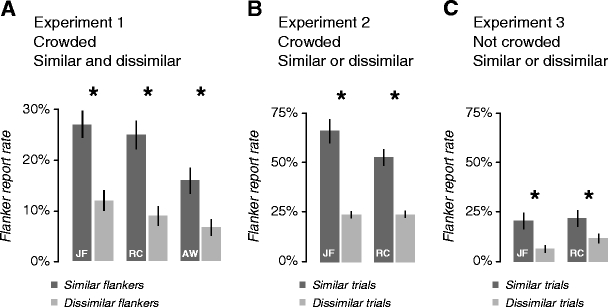Fig. 5.

The effect of crowding on flanker reports. a Flanker report rates in Experiment 1 for similar flankers (dark bars) and dissimilar flankers (light bars). All 3 observers reported the flanker that was similar to the target much more often than the one that was dissimilar. The error bars extend from the 16th to 84th percentiles of the bootstrapped distribution. The difference is significant for every observer and disproves the prediction of flanker substitution that similar and dissimilar reports are equally likely (*p < .01, two-sided permutation test). As part of a mixture model, flanker substitution can account for, at most, 55% of the trials (see the Results section, Table 1, and the Appendix, Eq. 4). b Flanker report rates in Experiment 2 on trials where the flankers were similar to the target (dark bars) and dissimilar (light bars). Both observers reported the flanker more than twice as often on similar than on dissimilar trials. The difference is significant for both observers (*p < .001, one-sided permutation test). Fitting all trials with a mixture model, we find that flanker substitution accounts for 29% of trials and target substitution accounts for 28%. The remainder (43%) require pooling (see the Results secion, Table 2, and the Appendix, Eq. 7). c Flanker report rates in Experiment 3, in which the letter triplets were presented at fixation to eliminate crowding. Without crowding, flanker reports are greatly reduced. In the mixture model, target substitution accounts for 84% of all trials, and substitution, of any kind, accounts for 92% (see the Results section, Table 3, and the Appendix, Eq. 22). Pooling (8%) is still needed to account for the discrepancy between similar and dissimilar trials
